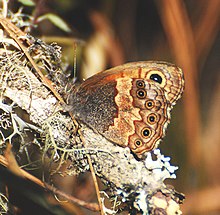Euptychiina
| Euptychiina | |
|---|---|

| |
| Arizona pine satyr (Paramacera allyni) | |
| Scientific classification | |
| Domain: | Eukaryota |
| Kingdom: | Animalia |
| Phylum: | Arthropoda |
| Class: | Insecta |
| Order: | Lepidoptera |
| Family: | Nymphalidae |
| Tribe: | Satyrini |
| Subtribe: | Euptychiina Reuter, 1896[1] |
| Genera | |
|
About 44, see text | |
Euptychiina is one of the largest subtribes of the butterfly subfamily Satyrinae (family Nymphalidae). The only two comprehensive studies that include Euptychiina are the works of L. D. Miller and Walter Forster,[2] though the latter is now largely considered obsolete.[citation needed]
Although the classification of brush-footed butterflies (Nymphalidae) is currently under heavy revision, the Euptychiina is still little-studied by taxonomists.[citation needed] In fact, the group is so difficult to classify that Bernard d'Abrera placed almost all Euptychiina in a so-called wastebasket genus that he called "Euptychia" in his popular guide to Neotropical butterflies.[3]
Taxonomy and evolution
A recent study proposes a hypothesis for the evolutionary relationships of Euptychiina, including estimates of time for the origin and diversification of major lineages, and also including a theory of biogeography for the group.[4] A recent study has shed some light on the taxonomy of the Taygetis clade and synonymized some genera and proposed new species combinations.[5] Moreover, Freitas et al.[6] described a new monotypic genus, Sepona, to accommodate the species Euptychia punctata, and its junior subjective synonyms Euptychia griseola and Taygetis indecisa, both formerly conceived within the genus Harjesia.[7]
Genera
Listed alphabetically:[8]
|
|
Footnotes
- ^ "Euptychiina". Integrated Taxonomic Information System (ITIS). Retrieved 2 November 2016.
- ^ Forster (1964), Miller (1968)
- ^ D'Abrera (1988)
- ^ Peña, C.; Nylin, S.; Freitas, A.V.L.; Wahlberg, N. (2010). "Biogeographic history of the butterfly subtribe Euptychiina (Lepidoptera, Nymphalidae, Satyrinae)". Zoologica Scripta. 39 (3): 243–258. doi:10.1111/j.1463-6409.2010.00421.x.
- ^ Matos-Maraví P.F., Peña C., Willmott K.R., Freitas A.V.L., Wahlberg N. 2012. Systematics and evolutionary history of butterflies in the “Taygetis clade” (Nymphalidae: Satyrinae: Euptychiina): Towards a better understanding of Neotropical biogeography. Molecular Phylogenetics and Evolution. 66:54–68. doi:10.1016/j.ympev.2012.09.005
- ^ Freitas, A.V.L., Barbosa, E.P., Willmott, K.R., Wahlberg, N. & Lamas, G., 2016: 'Species' from two different butterfly genera combined into one: description of a new genus of Euptychiina (Nymphalidae: Satyrinae) with unusually variable wing pattern. Revista Brasileira de Entomologia, 60: 157-165: Abstract and full article: doi:10.1016/j.rbe.2016.01.004
- ^ Lamas, Gerardo, 2004, Atlas of Neotropical Lepidoptera; Checklist: Part 4A; Hesperioidea-Papilionoidea
- ^ Subtribe Euptychiina at Markku Savela's Lepidoptera and Some Other Life Forms
References
- D'Abrera, B.L. (1988): The Butterflies of the Neotropical Region. Part 5. Nymphalidae (conc.), Satryidae. Hill House, Fearny Creek, Australia.
- Forster, W. (1964): Beiträge zur Kenntnis der Insektenfauna Boliviens XIX, Lepidoptera III, Satyridae ["Contributions to the knowledge of the insect fauna of Bolivia XIX"]. Veröffentlichungen der Zoologischen Staatssammlung München 8: 51-188, plates 127-135 [in German].
- Lehman, Richard (2007): Butterflies of Southern Amazonia. Neotropical Butterflies, Mission, Texas.
- Miller, L.D. (1968): The higher classification, phylogeny and zoogeography of the Satyridae. Memoirs of the American Entomological Society 24: 1-174.
- "Review of Euptychiina Systematics and Biology". Florida Museum of Natural History. University of Florida. Retrieved 2 November 2016.
